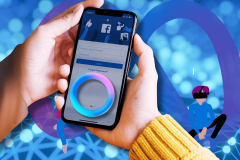
Twitter direct messages just got more talkative. Now you can have a private conversation with a group, the social network announced Tuesday.
Until now, Twitter’s direct messaging feature has been reserved for conversations between no more than two participants. Now, you can create groups of up to 20 Twitter users at the same time, and they do not have to be following one another to join. Group direct messages will support “text, photos, links, emoji and Tweets,” according to Twitter.
The feature is expected to roll out over the next couple of days to all users.
As Twitter has gotten noisier—and while messaging competitors like Snapchat and WhatsApp grew more significant—users have demanded improvements to its lightweight direct messaging feature, the only way to speak privately on the service. But Twitter has shown anything but a steady hand on the issue. Over the past two years it has lurched back and forth between opening up and restricting new features for direct message.
Here’s a quick timeline.
October 2013: You Can Receive Direct Messages From People You Don’t Follow
Prior to October 2013, two Twitter users had follow one another to exchange direct messages. Then Twitter inserted a new option where users could explicitly opt to receive direct messages from any of their followers, whether they followed them back or not. The Verge speculated the change allowed brands to have better access to consumers.
October 2013: Twitter Removes Link Sharing From Direct Messaging
That same month, Twitter users learned that they were unable to send links inside direct messages. This might have been a side effect of opening up DMs to a wider range of users, since it would have opened the door to spammy link-based advertising.
November 2013: Twitter Direct Messages Get A Makeover
Direct messages got a new look, one similar to iMessages. The feature began suggesting followers with whom users could begin a private conversation. The move was seen as part of a larger overhaul of direct messaging in order to compete with WhatsApp.
November 2013: Twitter Shuts Down Direct Messages From People You Don’t Follow
One short month later, Twitter decided fostering conversations between unverified users who don’t follow one another was a bad idea. The company does not respond to requests for comments, but reminds reporters it is “constantly experimenting.”
December 2013: Direct Messages Allow Private Photo Sharing
In a possible response to Snapchat’s visual success, Twitter began allowing people to share photos in privately in direct messages. Simultaneously, Twitter moved the direct messaging icon to a more prominent position on the top navigation bar of the homepage.
May 2014: Twitter Direct Messaging Still Has A Learning Curve
A few months after Twitter’s experimentation craze, ReadWrite reporter Selena Larson reflected on several embarrassing direct message mishaps, known colloquially as “DM fails,” in which users blasted messages to the world that they incorrectly thought would remain private. In a world where messaging services like Snapchat and WhatsApp were king, Twitter still lacked quality messaging.
November 2014: Tweet And Link Sharing Return To Direct Messaging
One year later, Twitter revived the ability to include links in direct messages. The social network described it as a secondary feature to the much acclaimed tweet sharing function, where users could take tweets from their timeline and share them privately.
January 2015: Group Messaging Supports Up To 20 Participants
Fast forward to the present, where Twitter is doubling down on direct messaging support. Users can share links, tweets, and emojis with up to 20 other users who may or may not be following one another. The feature includes elements Twitter has backtracked on in the past.
The real question is how long it’ll stick around before Twitter does its usual about face.
Illustration by Nigel Sussman for ReadWrite





















